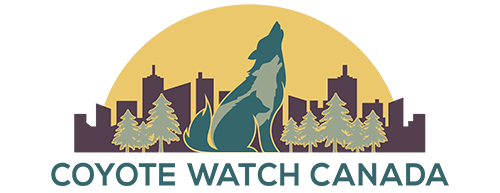
This past spring and summer I fell in love ... with coyotes. Until then, I had never seen one in real life, but instantly I became infatuated with their beauty. Yes, I have seen wildlife before, as we all have, but not something (on land) that was so near to the top of the food chain, an apex predator, and so fascinating. A pair of coyotes had made their home in my neighbourhood, so I didn't have to travel far to see them, and in fact, the one shown here actually made a brief appearance in my own backyard! It was incredible, I couldn't believe it, and from that moment on, I was totally hooked and constantly wanting to see them. They eventually had a litter of adorable pups too. When the weather was stormy, I would sometimes even lay awake at night thinking about them, wondering if they were ok. Yes, I had become obsessed, but obsessed in a good way, because I care about them.
As a wildlife photographer I absolutely love animals and nature, as many of us do, but the coyotes, to me, were extra special. They were not the typical community animal inhabitants one would expect to see around. Sure, out in a rural field perhaps, but a coyote in our urban neighbourhood?! It was truly remarkable to see them in our parks and trotting down the sidewalk, and for the most part, completely unphased by the presence of humans. Since my first and very memorable encounter, I have come to learn much about them, and with the extraordinary media attention they have received lately (and sadly, not much positive attention), it's hard not to want to learn more. They are very elusive, and for the MANY times I have been out looking for them, I have come home far more often disappointed than not, but when I do see one, I am always over-the-top excited!
Photography is my passion, and over time I have learned that not only is a great shot important to the photographer, but what is also very important, is how one gets the shot and the story it tells, especially when it comes to wildlife and nature. Apart from the requisite skill level, a great photo occurs when persistence, opportunity, and often a whole lotta luck come together. A great photo invokes a feeling or emotion in those who see it. What would our world be like without photos, and especially of things we may not have had the privilege to see and enjoy with our own eyes? It would be boring and dull. Wildlife is precious and treasured, and as part of our world, I believe we should feel obligated to respect it, and we should enjoy it. Yes, it is totally fine to take photographs to remember and share what we saw, to tell a story, but we need to do it in a way that preserves the 'wild' aspect of nature.
What does this mean? It means attempting to capture a photo in a way that does not upset the behaviour or existence of the animal being photographed. It means keeping your distance as much as possible (to whatever a particular animal is comfortable with), and with today's camera technology, that's not too difficult to do! Use a telephoto lens, and even when using a lens that's not super long, with the resolution of modern digital cameras and current editing software, it's very easy to crop a photo and make it look like you're much closer than you actually were! In the case of our coyotes, it also means not feeding them to get them to approach, but unfortunately, this has become a real problem in some areas. Feeding coyotes will condition the animal to associate food with people, and that's a very bad thing. Mother Nature and evolution have provided coyotes with ALL the necessary tools to feed themselves. We need to peacefully coexist with them - they go about their business, and we as humans go about ours - in the same area or community.
In all my encounters with the coyotes, I have never once felt fear or threatened in any way. Some have walked towards me (coming from wherever they're coming from), but in every circumstance, they take a wide pass around me. That's not aggression. Sometimes they pause briefly to have a look or a fleeting moment for a photo op, sometimes they don't. I have observed them in the presence of people out for walks and in parks, but do not see them as aggressive animals. They do what all wild animals do, hunt for food to survive as a necessity, and protect & provide for their family. People just need to remain cautious and be aware of their presence, respect them for what they are, wild, and when we do that, coyotes will simply coexist as nature intended. It's not rocket science, it's common sense.
Ethical photography is important to the well-being of all wildlife. We owe it to the wildlife, and we owe it to our delicate ecosystem that can very easily be disturbed. Every creature plays a vital role, no matter how big or how small, and every creature has an important place in nature - take one out and something else falls out of balance, on land, in the air, or in water. These beautiful coyotes need our advocacy and voice to keep them safe and part of our diverse world. They live in an environment that has many threats to their wellbeing - the forces of nature, disease, humans, and motor vehicles. Intensely dedicated and loyal to their families and offspring, so adaptive and smart, and so INSANELY beautiful, they are some of the most amazing animals I have ever seen. We should feel blessed to have them so close to home, in a shared urban environment.
Guest blog author - Jeff Arnold
To learn more about Jeff's work visit his Instagram @jeffarnold1963

